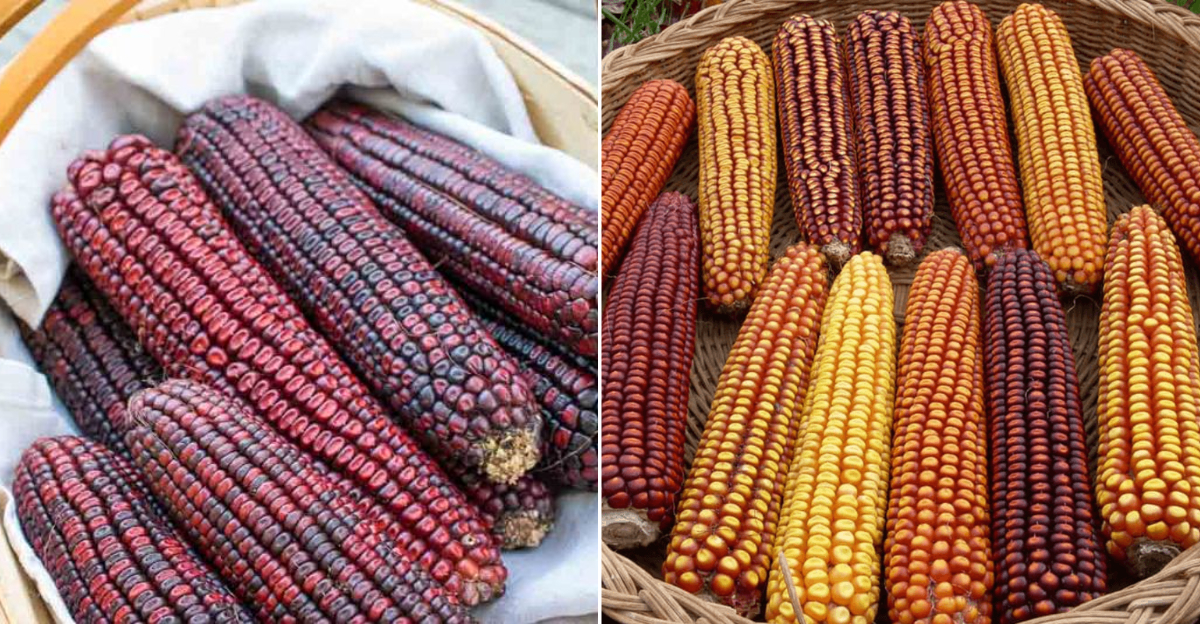16 Lesser-Known Corn Varieties Worth Discovering

Corn isn’t just yellow and sweet. Hidden in husks across the country are lesser-known varieties that bring surprising color, flavor, and flair to your plate.
From deep purple kernels that pop with nuttiness to heirloom gems perfect for grinding into tortillas, these overlooked types deserve a moment in the spotlight.
Whether you’re a home cook, foodie, or garden geek, exploring the world of corn might just change the way you think about this humble crop.
1. Glass Gem
Imagine corn that looks like stained glass! Glass Gem bursts with translucent kernels in blues, purples, reds, and golds on each cob.
Originally developed by Carl Barnes, a part-Cherokee farmer from Oklahoma, this variety became an internet sensation when photos went viral in 2012.
While primarily grown for ornamental purposes, it makes excellent popcorn and flour.
2. Oaxacan Green Dent
Lime green kernels make this Mexican heirloom an immediate attention-grabber in any garden. The substantial cobs feature large, emerald-colored kernels that almost glow in sunlight.
Farmers in Oaxaca, Mexico have grown this variety for centuries. Ground into masa, it creates naturally green tortillas without food coloring.
The kernels maintain their vibrant hue even after cooking, making for conversation-starting cornbread.
3. Bloody Butcher
Sporting a name as memorable as its appearance, Bloody Butcher corn boasts deep red kernels with occasional streaks of white and purple.
Some say it resembles splattered blood (hence the somewhat gruesome name). Dating back to the 1840s in Virginia, this variety matures quickly, making it perfect for northern climates.
Moonshiners historically favored it for whiskey, while modern chefs prize its nutty, sweet flavor for cornmeal and grits.
4. Blue Hopi
Sacred to the Hopi people of the Southwest, this stunning blue corn variety has been cultivated for over 800 years. The kernels range from steel blue to nearly purple, creating a striking visual.
Rich in anthocyanins (the same antioxidants found in blueberries), Blue Hopi contains 20% more protein than yellow varieties.
When ground, it produces distinctively blue tortillas and piki bread, a traditional Hopi food made on hot stones.
5. Wapsie Valley
Named after Iowa’s Wapsipinicon River, this corn variety delivers a surprise on every stalk. Each plant produces both yellow and reddish-bronze ears, sometimes on the same stalk!
Farmers appreciate its adaptability to organic growing conditions and resistance to common corn diseases.
With exceptional nutrition and a rich, buttery flavor, Wapsie Valley makes phenomenal cornmeal that outshines store-bought versions by miles.
6. Strawberry Popcorn
No, it doesn’t taste like strawberries! The name comes from the adorable ruby-red ears shaped remarkably like the fruit.
Each compact cob typically measures just 2-3 inches long. Victorian gardeners grew these decorative cobs as Christmas ornaments and gifts.
Beyond looks, the tiny kernels pop into tender, nutty popcorn that puts movie theater varieties to shame. Kids particularly love growing these miniature marvels.
7. Black Aztec
Kernels that start bluish-white and ripen to a deep purple-black make Black Aztec corn a garden showstopper.
First commercially offered in seed catalogs in 1864, this variety dates back to ancient Aztec cultivation. Sweet and tender when harvested young as corn on the cob.
Left to mature, the ebony kernels create dramatically dark cornmeal and flour. Home bakers love using it for blue-black cornbread that turns heads at dinner parties.
8. Hickory King
Giants in the corn world! Hickory King produces towering 12-foot stalks topped with massive cobs featuring the largest kernels of any corn variety.
The bright white kernels are so big that reportedly only 8 rows fit around each cob. Southern farmers have grown this variety since the 1880s.
Particularly suited for grits and hominy, it’s also the traditional choice for making moonshine in Appalachia. The sturdy stalks double as natural trellises for climbing beans.
9. Trucker’s Favorite
Legend has it this variety earned its name from truck farmers who found it sold fastest at roadside stands. The attractive pink-purple kernels transform to deep rose-colored when cooked.
Popular throughout the South since the 1800s, Trucker’s Favorite tolerates drought and poor soil like a champion.
The multi-purpose corn works beautifully for roasting ears, creamed corn, or grinding into meal. Gardeners love its reliability even during challenging growing seasons.
10. Mandan Bride
Kernels in rainbow swirls of blue, white, red, and yellow make Mandan Bride corn a living piece of art. Developed by the Mandan tribe of North Dakota, this variety carries deep cultural significance.
According to tradition, a woman gifted with this corn could make beautiful patterned cornmeal as her wedding approached.
The striking multicolored kernels grind into speckled flour that creates uniquely patterned breads. Hardy enough for short northern growing seasons.
11. Golden Bantam
Revolutionary when introduced in 1902, Golden Bantam changed America’s corn preferences forever! Before its arrival, Americans only ate white sweet corn, believing yellow corn was fit only for animals.
Farmer William Chambers developed this variety in Massachusetts, and Burpee Seeds made it famous. Its rich, buttery flavor converted skeptics to yellow corn enthusiasts.
Though smaller than modern hybrids, many gardeners still consider it the gold standard for sweet corn flavor.
12. Painted Mountain
Born from a 40-year breeding project in Montana, Painted Mountain corn brings rainbow colors to extreme climates. Each cob displays a unique pattern of reds, blues, purples, whites, and golds.
Dave Christensen created this variety by gathering nearly 70 traditional corns from Native tribes throughout the northern plains.
Incredibly cold-hardy, it matures in just 90 days at elevations up to 7,000 feet. Survivalists value it for food security in challenging environments.
13. Japonica Striped
Corn as ornamental as any flower! Japonica Striped features not just colorful kernels but spectacular variegated leaves and tassels striped in green, white, pink, and purple.
The entire plant serves as a garden showpiece. Originally from Japan, this variety was primarily grown for its decorative value in Victorian gardens.
The kernels themselves come in shades of burgundy and purple. Though edible, most growers harvest the plants for stunning dried arrangements that last for years.
14. Cherokee White Eagle
Sacred to the Cherokee Nation, White Eagle corn features striking blue kernels with distinctive white tops that resemble the head of a white eagle. No two cobs have exactly the same pattern.
This variety carries profound cultural significance, used in ceremonies and as a staple food. The corn produces excellent cornmeal and hominy with a rich, nutty flavor.
Cherokee families have preserved these seeds through generations, including during the Trail of Tears forced migration.
15. Dakota Black
Jet-black kernels with a purple sheen make Dakota Black popcorn instantly recognizable. When popped, the dark exterior creates snowy white popcorn with black-speckled hulls and a nutty flavor that outshines movie theater varieties.
Developed in the northern plains, this variety thrives in cooler climates. The 4-5 inch ears mature on compact 5-foot plants, making it suitable for smaller gardens.
Chefs prize it for gourmet popcorn dishes where its distinctive appearance and flavor command premium prices.
16. Roy’s Calais Flint
Glistening golden-orange kernels arranged in arrow-straight rows distinguish Roy’s Calais Flint corn. Each cob looks meticulously arranged by hand, though nature created this precise pattern.
Preserved by the Abenaki tribe in Vermont and named after keeper Roy Palone from Calais, Vermont. This flint corn withstands cold New England springs.
Its exceptional hardiness and resistance to weevils made it valuable for winter storage. Grinds into cornmeal with remarkable sweetness without added sugar.
